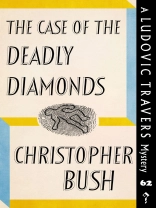‘I just wanted to ask you one question.’
‘Yes?’
‘Why did you lie to us about that burglar?’
The Case of the Deadly Diamonds starts out as a small-scale caper for Ludovlc Travers, leading light of the Broad Street Detective Agency. The unspectacular sum of two hundred pounds had vanished mysteriously from a safe in the home of Paul Morren, an old-guard London jeweller.
But when Travers moves in to investigate for the Insurance company, the case erupts into a bona fide spectacular involving the theft of a fortune in diamonds, armed bank robbery, and a bloody climax of multiple murder and suicide.
The key to the Morren family’s liaison with death and diamonds lies with heir-turned-criminal David Wayner. But he isn’t talking.
And since the Morrens are such accomplished liars, Travers has to rely on what corpse number one and corpse number two can tell him about who corpse number three will be-before he can engineer a perilous confrontation with the desperate keeper of the diabolical gems.
The Case of the Deadly Diamonds was originally published in 1967. This new edition features an introduction by crime fiction historian Curtis Evans.
Circa l’autore
Christopher Bush was born Charlie Christmas Bush in Norfolk in 1885. His father was a farm labourer and his mother a milliner. In the early years of his childhood he lived with his aunt and uncle in London before returning to Norfolk aged seven, later winning a scholarship to Thetford Grammar School.As an adult, Bush worked as a schoolmaster for 27 years, pausing only to fight in World War One, until retiring aged 46 in 1931 to be a full-time novelist. His first novel featuring the eccentric Ludovic Travers was published in 1926, and was followed by 62 additional Travers mysteries. These are all to be republished by Dean Street Press.Christopher Bush fought again in World War Two, and was elected a member of the prestigious Detection Club. He died in 1973.












